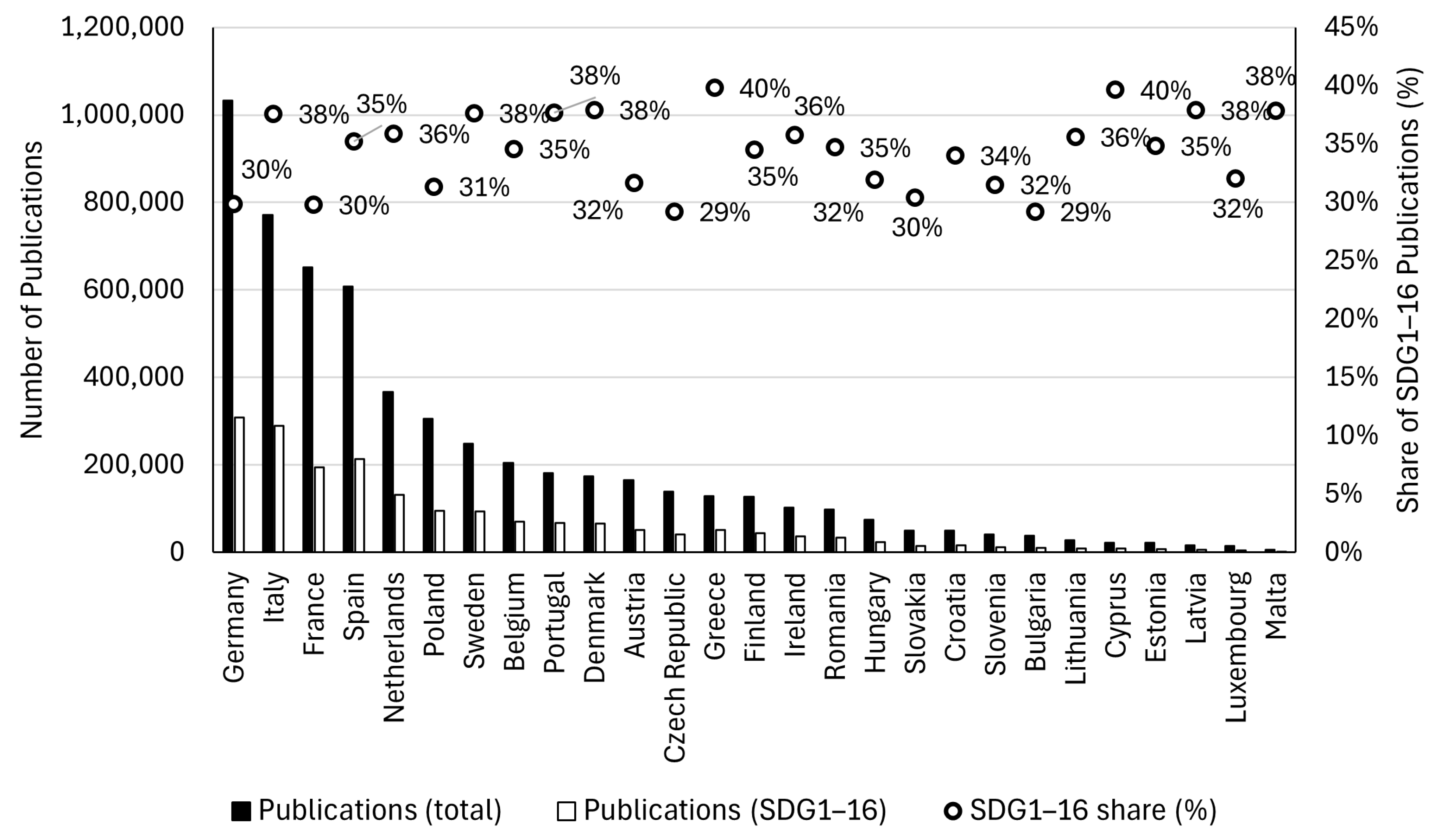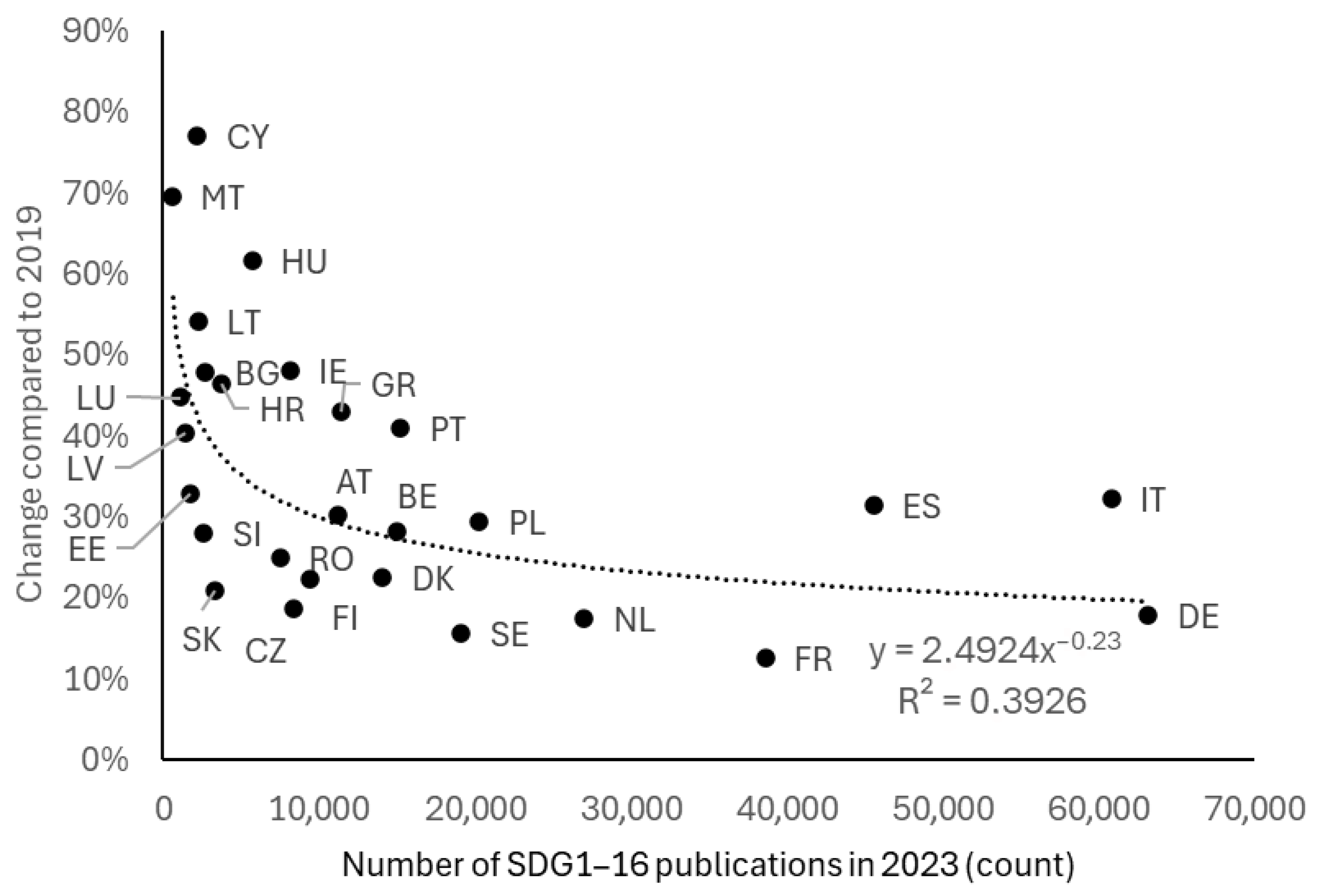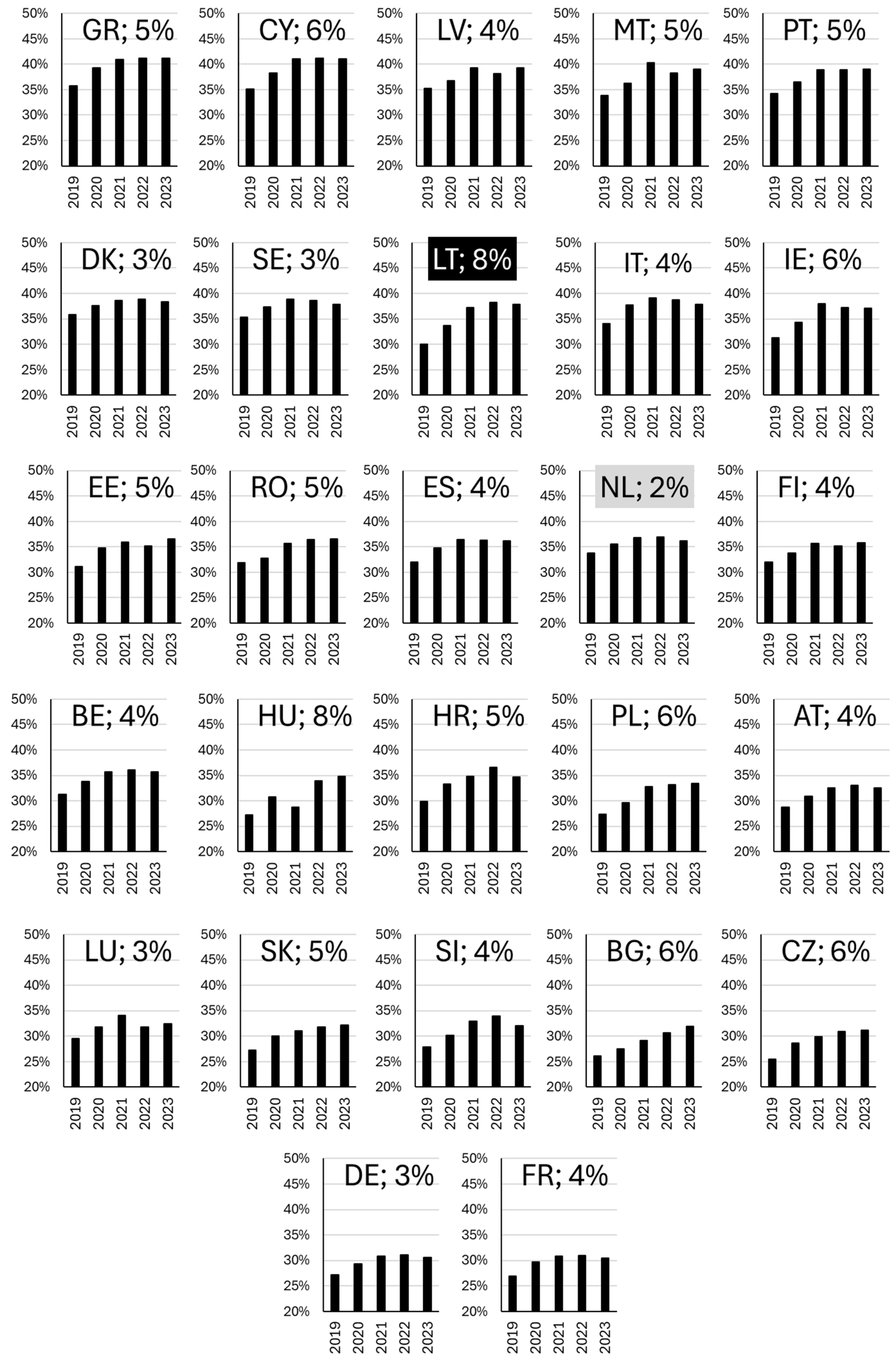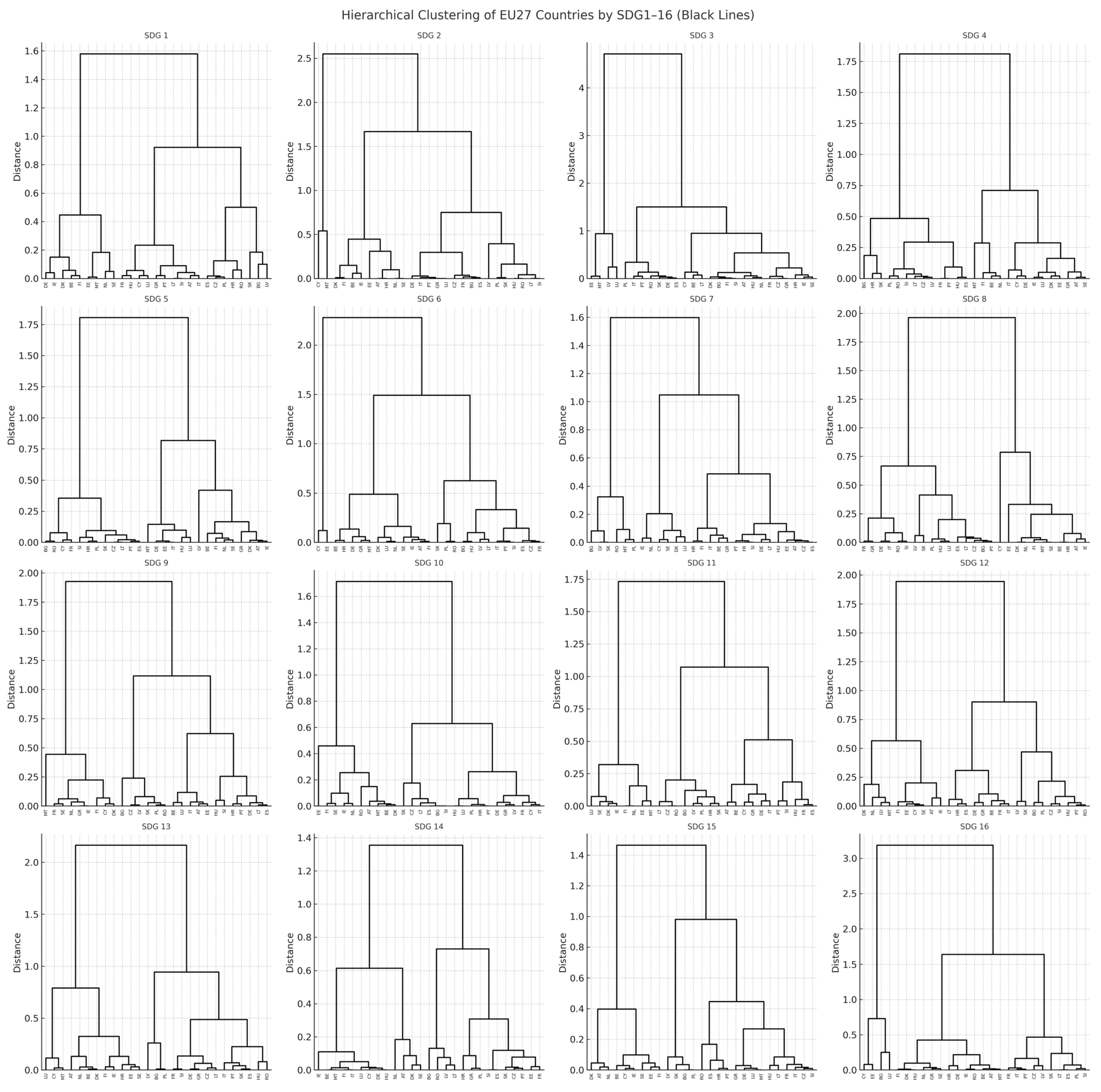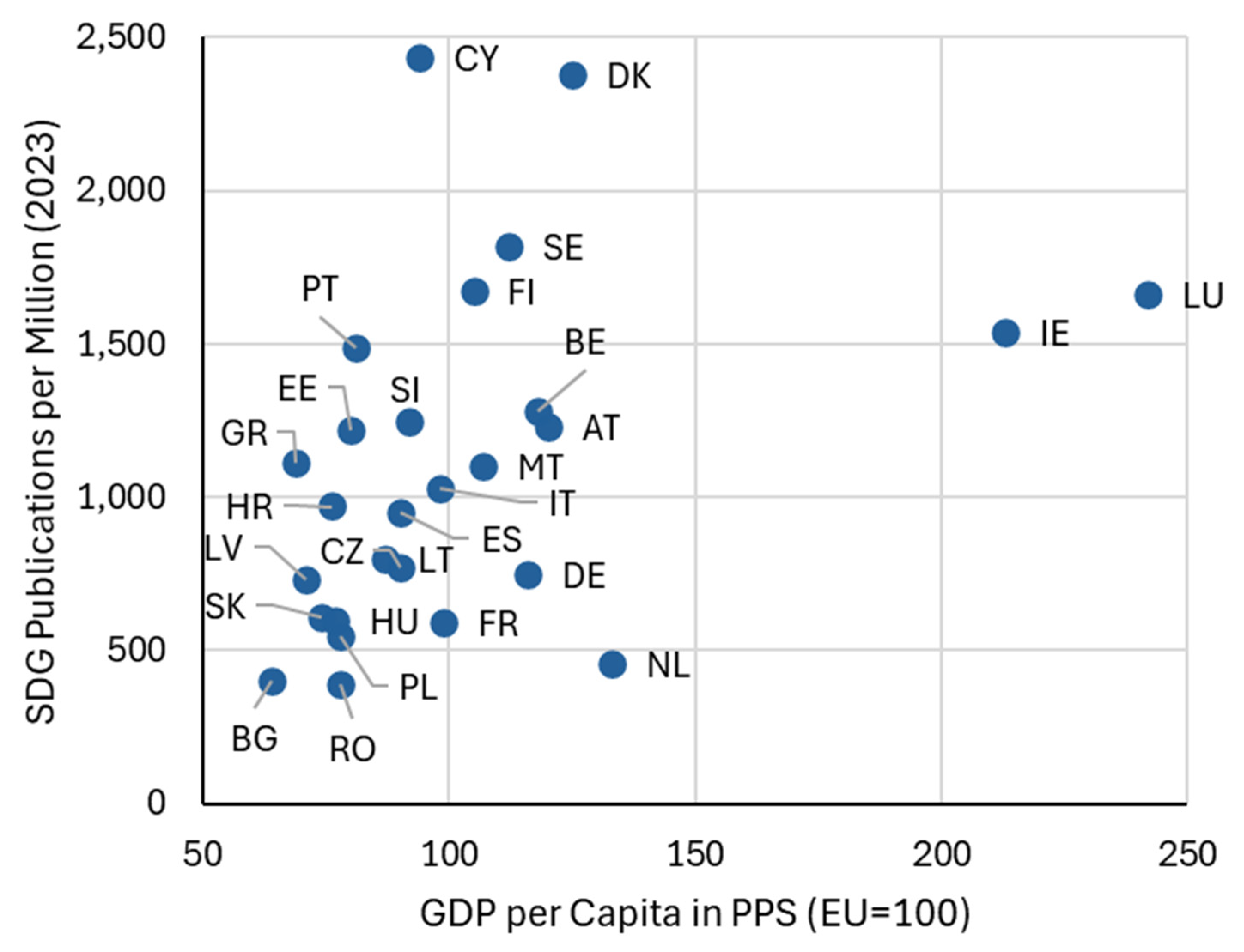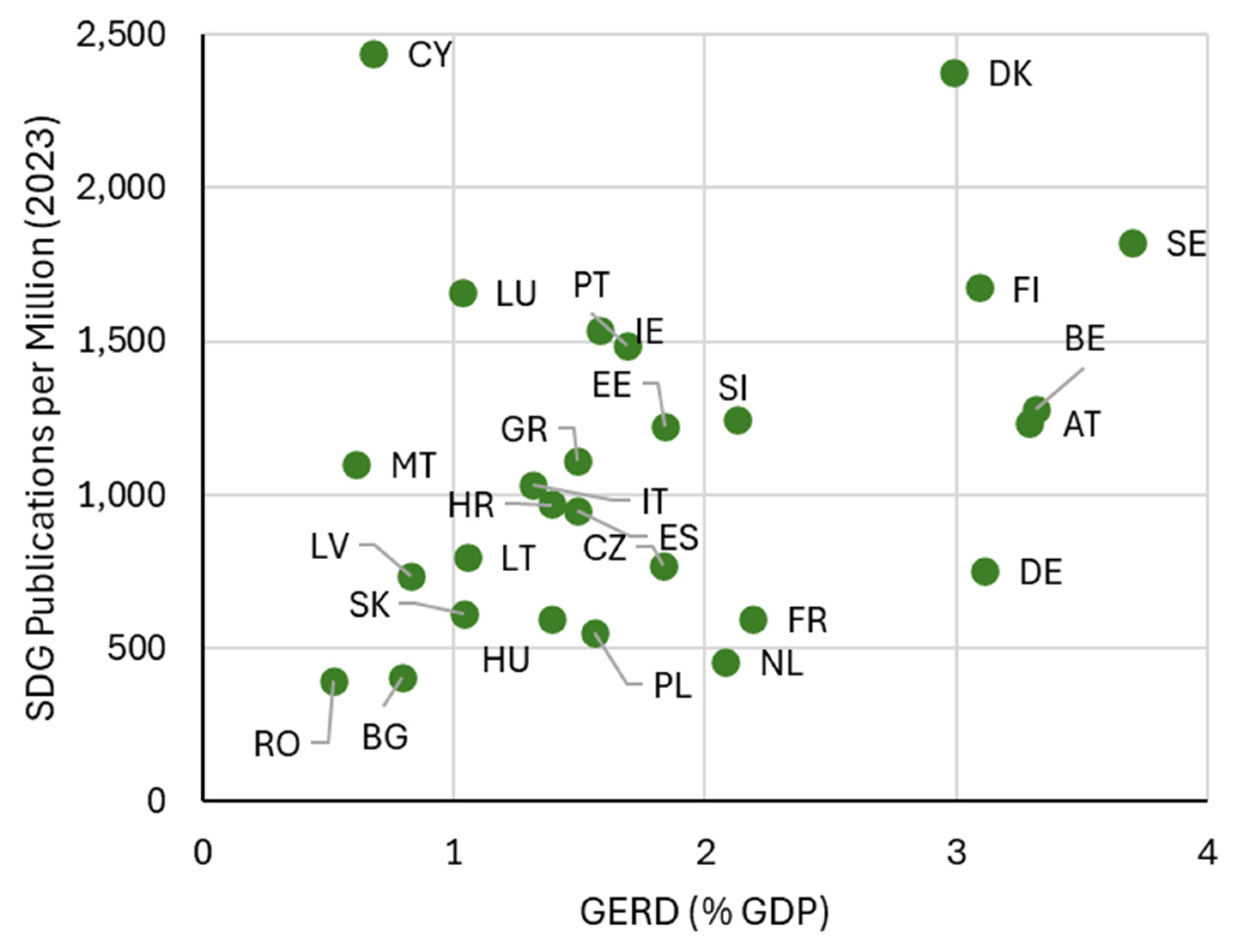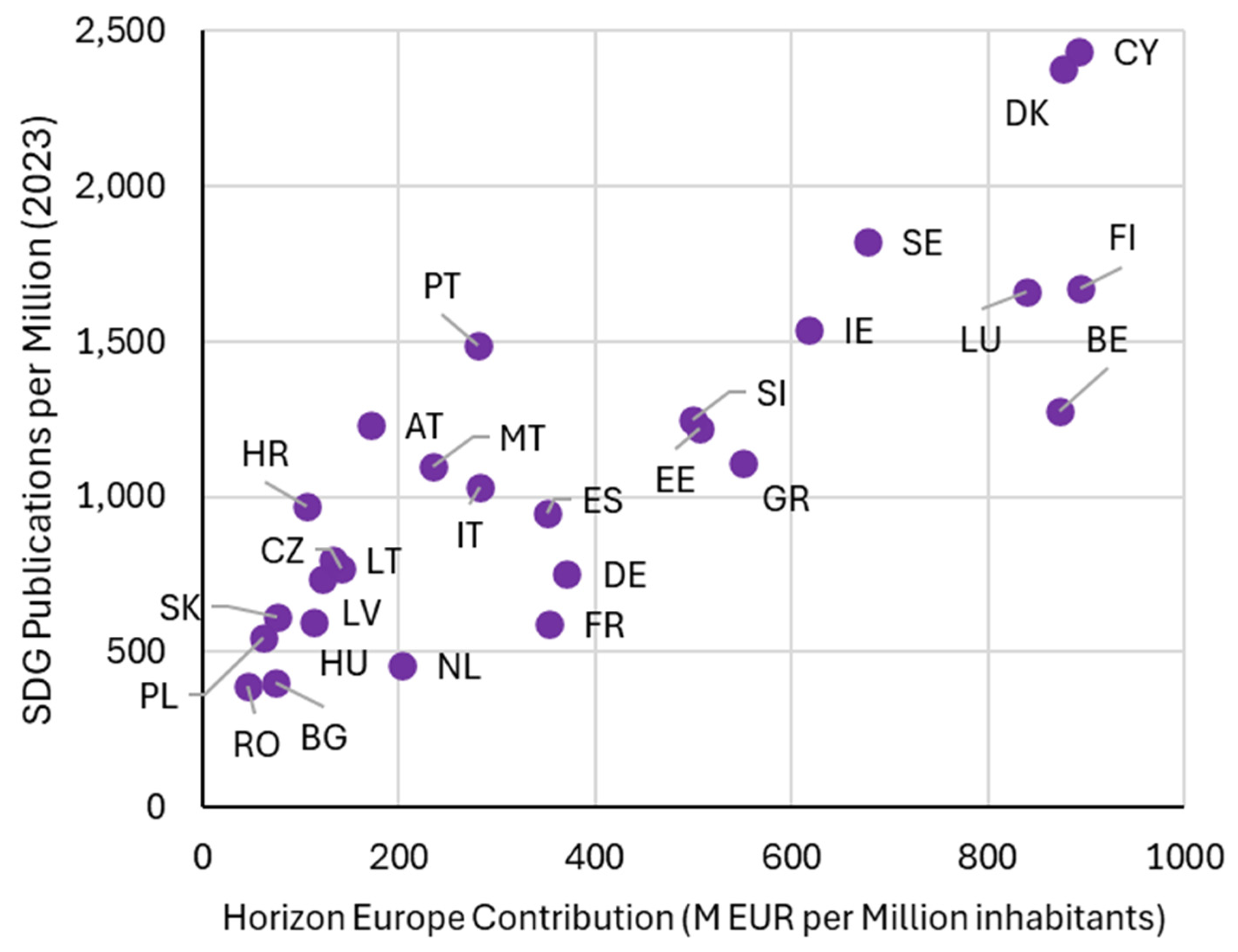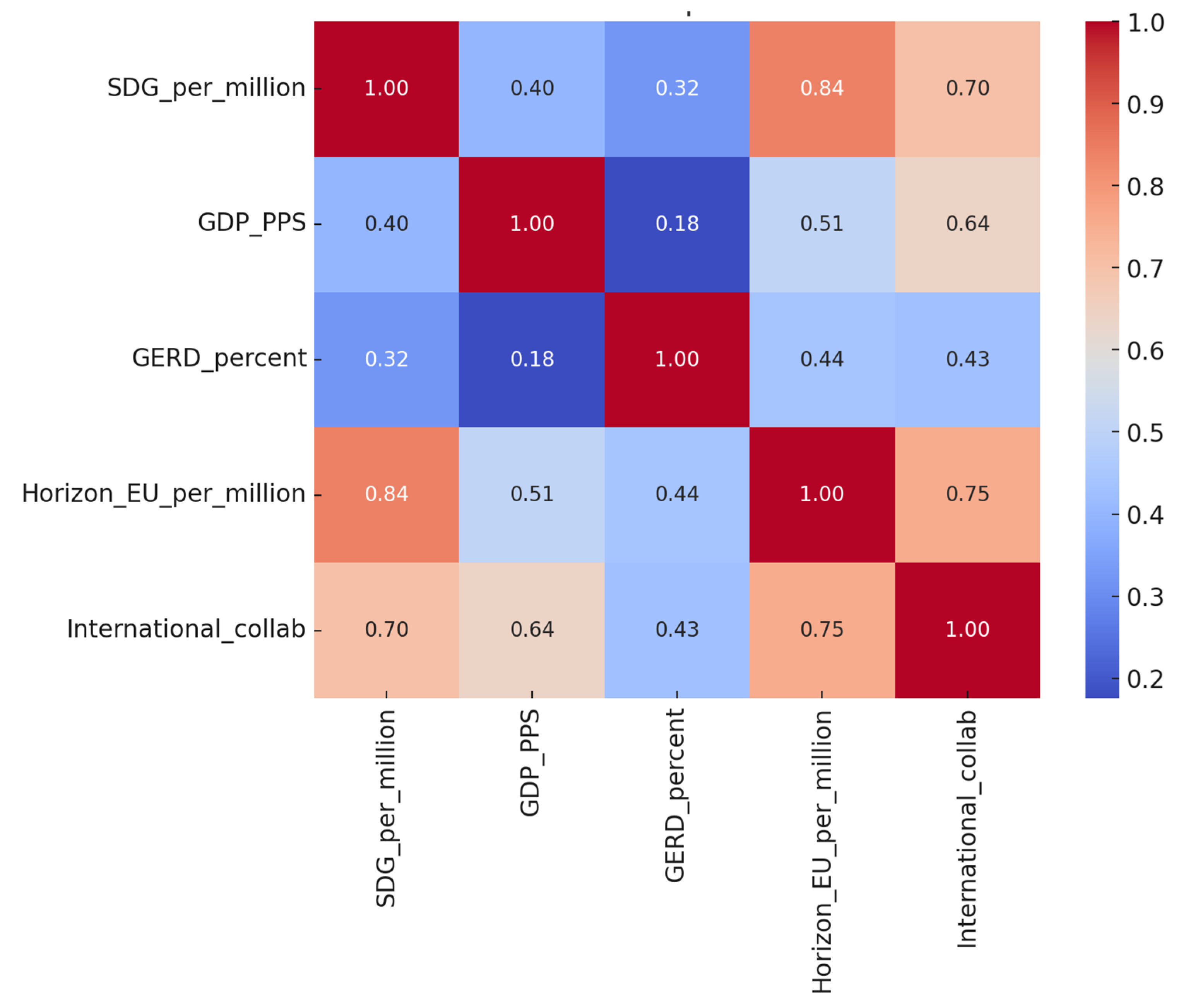1. Introduction
The United Nations Sustainable Development Goals (SDGs) have become a pivotal benchmark for both academia and policymakers worldwide. Despite the rapidly expanding literature, significant gaps remain. Most existing bibliometric analyses have focused either on global trends (
Griggs et al., 2013) or on individual SDGs (e.g., SDG3, SDG7). Few studies provide a systematic, comparative perspective across all EU27 countries. Moreover, while prior analyses describe publication volumes and citation metrics, they rarely link bibliometric performance to explanatory factors such as economic capacity, R&D investment, or access to EU programs. Addressing these gaps is essential for understanding structural differences within the European Research Area.
Since the adoption of the 2030 Agenda by the UN General Assembly in 2015, research institutions and funding agencies have increasingly aligned their priorities with the SDG framework (
Griggs et al., 2013;
Sachs et al., 2019). Bibliometric indicators provide a systematic way to assess how countries contribute to SDG-related knowledge production (
Elsevier, 2020). Despite the rapid growth of SDG-related publications, there is still limited understanding of how national research performance—particularly in smaller or emerging EU economies—relates to broader science policy contexts and sustainability transitions.
This study addresses that gap by systematically evaluating performance differences and emerging patterns across the EU27. Our approach combines multiple bibliometric indicators (publication volume, relative share, citation impact, and growth dynamics) with contextual drivers (economic capacity, R&D investment, Horizon Europe funding, and international collaboration). In doing so, we aim to provide a multidimensional perspective on how EU member states engage with SDG-related research and to identify structural differences across national research systems.
The remainder of the article is structured as follows:
Section 2 reviews the relevant literature on SDG-related bibliometrics;
Section 3 details the methodology and data sources;
Section 4 presents the results of the bibliometric and cluster analyses;
Section 5 discusses the explanatory drivers and policy implications; and
Section 6 concludes with key findings, limitations, and directions for future research.
To guide the empirical analysis, we developed a conceptual framework of SDG research performance drivers (
Figure 1). This model illustrates the interaction between national context, institutional capacity, and research performance. The national context—including economic structure, science policy, and access to EU funds—is linked to institutional capacity in terms of infrastructure, research networks, and human capital. These elements are associated with differences in research performance, as measured by bibliometric indicators such as publication volume, growth rate, and Field-Weighted Citation Impact (FWCI). The model also highlights the feedback loop between research performance and policy implications, including targeted funding mechanisms and collaboration strategies. Although simplified and not exhaustive (e.g., excluding disciplinary specialization or language barriers), the framework provides a basis for operationalizing and testing explanatory relationships in the subsequent analysis.
While numerous studies document publication trends and bibliometric performance metrics, few explicitly examine the interaction between thematic concentration, research impact, and temporal dynamics. The current study addresses this gap through an integrated analysis of growth patterns and cross-national comparisons. Moreover, the existing literature offers limited insights into clustering EU countries based on SDG research characteristics beyond general sustainability indices. The cluster-based taxonomy introduced here contributes to a more nuanced typology of EU27 research systems and provides a foundation for targeted science policy interventions.
While previous studies have mapped general SDG-related publication trends or focused on specific goals (e.g., SDG3, SDG7, or SDG12), few have combined multiple bibliometric indicators to provide a multidimensional evaluation of national research performance. The present study contributes to the literature by offering an integrated framework that combines publication volume, relative share, citation impact, and growth rates, thereby capturing both scale and efficiency dimensions. Furthermore, the hierarchical clustering approach adopted here—validated through silhouette and agglomeration measures—introduces a robust typology of EU27 research systems, distinguishing between leaders, diversified performers, and emerging contributors. Unlike global-level assessments or single-SDG analyses, this study operationalizes a conceptual framework that links bibliometric outcomes to measurable contextual variables, including GDP per capita, GERD, Horizon Europe participation, and international collaboration. This positioning highlights the novelty of the study as both a methodological contribution and a policy-relevant analysis tailored to the European research landscape.
Overall, the literature depicts a rapidly maturing research ecosystem centered on the SDGs, marked by increasing analytical sophistication and growing policy relevance. Nonetheless, key challenges persist, including thematic imbalances, methodological inconsistencies, and geographic disparities. By synthesizing insights from prior bibliometric and policy-oriented studies, the present research enhances our understanding of how EU countries engage with the SDG agenda through science and offers a robust framework for future comparative and evaluative analysis.
This study draws on existing literature in sustainability science, bibliometrics, and research policy to frame its analytical approach. Recent research demonstrates a substantial increase in SDG-related publications, particularly in environmental and health-focused domains. Interdisciplinary collaboration and international partnerships have been identified as key drivers of research impact. Furthermore, macroeconomic factors such as GDP per capita and digital readiness are known to influence the intensity of SDG-related research efforts across countries.
Based on these considerations, the study addresses three core research objectives:
RO1: Quantify each EU27 country’s contribution to SDG1–16 research relative to its total scientific output.
RO2: Identify clusters of countries based on SDG publication volume, relative share, and citation impact (FWCI).
RO3: Analyze temporal trends (2019–2023) in SDG publication share and growth and examine contributing factors such as national funding schemes and participation in EU initiatives (e.g., Horizon Europe).
The remainder of the paper is structured as follows:
Section 2 reviews the literature on SDG-related bibliometric analyses and identifies key methodological debates.
Section 3 details the materials and methods, including data sources, indicators, and analytical techniques.
Section 4 presents the results of the bibliometric and cluster analyses.
Section 5 discusses explanatory drivers, high-performance patterns, emerging dynamics, and policy implications. Finally,
Section 6 concludes with key findings, limitations, and avenues for future research.
3. Materials and Methods
3.1. Data Collection
The bibliometric data used in this study were extracted from Elsevier’s Scopus database, with the metadata snapshot taken in February 2024. To ensure thematic alignment with the Sustainable Development Goals (SDGs), we included all document types tagged with SDG1 through SDG16, as classified by the SciVal platform. These encompassed peer-reviewed articles, reviews, book chapters, conference proceedings, and other indexed publication types. We retained all Scopus-indexed document types because they are part of SciVal’s predefined SDG classification and ensure consistency across countries. Excluding certain categories (e.g., conference proceedings or book chapters) could introduce disciplinary and regional biases, as research traditions vary substantially across fields and national contexts. Moreover, the Field-Weighted Citation Impact (FWCI) indicator is normalized by document type, which mitigates potential distortions.
Duplicate handling: Publications tagged with multiple SDGs were counted once for each SDG they were associated with, in line with SciVal’s tagging. For example, if a publication was tagged with both SDG3 and SDG12, it contributed one count to each respective goal. This approach allows for independent thematic analysis of SDG domains. However, when aggregating data at the country level (i.e., total publications per country), each publication was counted only once to avoid double-counting. No additional deduplication procedures were required, as the Scopus–SciVal export ensured publication-level consistency.
SDG17 (Partnerships for the Goals) was not included in the analysis because SciVal does not currently assign publications to this goal using its automated classification scheme. As a result, relevant outputs could not be systematically captured through the same methodological framework. We acknowledge the strategic importance of SDG17 and recommend that future studies apply alternative content- or network-based approaches to identify partnership-oriented research.
International co-authorship: In publications involving authors from multiple countries, each country was credited with one full publication count. We did not apply fractional counting based on the number of authors or affiliations, in order to reflect the inclusive nature of international scientific collaboration. This whole counting approach is consistent with SciVal’s country-level reporting and facilitates straightforward comparison of national contributions.
No language filters were applied, as SciVal’s SDG classification scheme covers all indexed publications irrespective of language. Likewise, self-citations were not explicitly removed, since the FWCI indicator provided by SciVal is normalized at the global level and inherently mitigates the effect of self-citation patterns.
In addition to bibliometric publication data, we also collected contextual indicators to operationalize the elements of the conceptual framework presented in
Figure 1. Economic context was represented by GDP per capita in purchasing power standards (PPS,
Eurostat, 2023). Research investment was measured by gross domestic expenditure on R&D (GERD, % of GDP,
Eurostat, 2023). Access to EU funds was proxied by Horizon Europe net contributions per capita, obtained from the Horizon Dashboard of the European Commission. Finally, international collaboration capacity was measured by the share of co-authored publications with international partners, as reported by SciVal. These contextual variables were integrated with bibliometric indicators to enable explanatory analyses of SDG-related research performance across EU27 countries.
3.2. Indicators
Four key bibliometric indicators were employed to evaluate SDG-related research performance across EU27:
Publication count (PC): The absolute number of SDG-tagged publications produced by each country.
Relative share (RS): The ratio of SDG-related publications to a country’s total scientific output, indicating the proportion of national research devoted to SDG themes. RS was calculated as follows:
where
i denotes the country, and both numerator and denominator refer to Scopus-indexed outputs during 2019–2023.
Field-Weighted Citation Impact (FWCI): The ratio of actual citations received to the expected citation rate for similar publications in the same field, year, and document type. This normalized metric enables cross-disciplinary comparisons of research impact.
Growth rate (GR): Measured as the compound annual growth rate (CAGR) of SDG-related publications between 2019 and 2023, capturing the dynamic evolution of national engagement in sustainability-focused research. CAGR was computed as follows:
where
Vt is the number of SDG-related publications in 2023,
V0 is the corresponding figure for 2019, and
t is the number of years (four).
The four selected indicators (PC, RS, FWCI, and GR) were chosen because they capture both the scale and quality of research outputs and are widely used in policy-oriented bibliometric evaluations (
Donthu et al., 2021). While other indicators (e.g., h-index, network centrality) are available in tools such as Bibliometrix or VOSviewer version 1.6.21, these were excluded because the focus of this study is comparative performance at the country level, rather than detailed citation network mapping.
In addition to bibliometric measures, four contextual indicators were introduced to operationalize the conceptual framework shown in
Figure 1:
Economic context: measured by GDP per capita in purchasing power standards (PPS, EU = 100,
Eurostat, 2023).
Research investment: proxied by gross domestic expenditure on R&D (GERD, % of GDP,
Eurostat, 2023).
Access to EU funds: represented by Horizon Europe contribution per capita (million EUR per million inhabitants), retrieved from the European Commission’s Horizon Dashboard.
International collaboration: measured by the share of SDG-related publications co-authored with international partners, as reported by SciVal.
Together, these bibliometric and contextual indicators enabled a multidimensional assessment of SDG-related research performance across EU27 countries, linking the conceptual framework to measurable variables.
3.3. Analytical Techniques
A combination of quantitative techniques was used to analyze the dataset. Descriptive statistics summarized the central tendencies and variability of PC, RS, and FWCI across EU27 countries. Trend analysis was conducted by examining annual changes in RS and PC between 2019 and 2023, visualized through charts to identify patterns of acceleration or stagnation in SDG research output. All statistical analyses were performed using SPSS Statistics 22, and visualizations were generated with Excel.
To classify countries into distinct performance typologies, hierarchical cluster analysis was performed using Ward’s minimum variance method, applied to standardized values of PC, RS, and FWCI. This enabled the identification of structurally similar country groupings based on both research volume and citation impact. To evaluate the reliability of the cluster solutions, internal validation metrics such as silhouette scores and agglomeration coefficients were calculated. These methods helped to assess the coherence of identified clusters.
In addition, to operationalize the conceptual framework presented in
Figure 1, explanatory analyses were conducted by linking bibliometric outcomes to contextual indicators (GDP per capita, GERD as % of GDP, Horizon Europe funding per capita, and international collaboration rates). These associations were visualized through scatter plots and further tested using Pearson correlation coefficients. This step allowed us to move beyond purely descriptive statistics and examine the strength of relationships between research performance and broader structural factors, while avoiding direct causal inference.
To validate the robustness of the clustering solution, we calculated silhouette coefficients and examined the agglomeration schedule. The three-cluster solution yielded an average silhouette coefficient of 0.35, indicating a moderate degree of internal consistency. Robustness checks were conducted by testing two- and four-cluster solutions, which yielded weaker silhouette scores. This confirms that the three-cluster typology balances statistical adequacy with conceptual clarity. Alternative solutions with two or four clusters were also tested but produced lower silhouette values and less-interpretable groupings. The choice of three clusters therefore reflects both statistical adequacy and conceptual clarity, as it distinguishes between leading, diversified, and emerging research systems within the EU27.
3.4. Limitations
While the methodology provides consistency and comparability, several limitations should be acknowledged. Firstly, the thematic tagging of publications to specific SDGs in Scopus and SciVal may be subject to both under- and over-classification, which may distort the representation of certain goals. Secondly, the exclusion of SDG17—due to its ambiguous classification and thematic overlap—may introduce a slight bias in the overall thematic distribution, particularly given its integrative role within the 2030 Agenda. Therefore, caution is warranted when interpreting the comprehensiveness of SDG coverage across the EU27 research landscape. It is worth noting that this study does not analyze the alignment between national SDG strategies and academic research agendas. Therefore, the attribution of publication outputs to national policy priorities should be interpreted with caution. In addition to the risk of misclassification, SciVal’s proprietary tagging algorithm may favor certain disciplines, publication types, or keyword structures, which could skew the representation of interdisciplinary or emerging SDG themes. While the platform ensures consistency, it limits transparency and reproducibility.
Moreover, full reproducibility of the data extraction process is constrained by the proprietary nature of the SciVal classification system and institutional licensing requirements. No language filters were applied in the analysis, which ensured broad coverage across the EU27 but may also amplify the dominance of English-language outputs. Self-citations were not explicitly excluded, as the Field-Weighted Citation Impact (FWCI) provided by SciVal is normalized at the global level and partially mitigates citation biases; nevertheless, some residual effects of self-citation cannot be ruled out.
In addition, although the conceptual framework presented in
Figure 1 was partially operationalized through measurable indicators (GDP per capita, GERD, Horizon Europe funding, and international collaboration), several other potential drivers could not be included due to data limitations. Factors such as disciplinary specialization, language barriers, institutional governance, or national research strategies were not systematically quantified in this study. As a result, the explanatory analysis captures only part of the broader set of influences shaping SDG-related research performance, and future research should aim to integrate these additional dimensions.
These limitations are consistent with broader concerns raised in recent bibliometric literature. For instance, Taques (
Taques, 2025) highlights common challenges in large-scale bibliometric studies, including the dependency on proprietary data sources, inconsistencies in classification systems, and restricted reproducibility due to licensing constraints. Similar to the PATSTAT-based patent study, our reliance on SciVal’s internal SDG tagging and limited access to the full metadata structure prevents complete methodological transparency. Both studies underscore the need for open data frameworks and harmonized indicator sets to improve reproducibility, cross-country comparability, and policy relevance in future research.
4. Results
4.1. Overall Publication Landscape
An analysis of total publication output across the EU27 reveals that Germany is the leading contributor, with 1,033,178 publications recorded during the study period. Of these, 30% (309,953) are classified as SDG-related, underscoring Germany’s prominent role in sustainability-oriented research. Italy ranks second, with 771,456 publications, of which a comparatively higher 38% are SDG-tagged. France follows with 651,344 total outputs and a 30% share of SDG-related publications.
Figure 2 presents the overall publication performance of EU27 countries and the share of SDG1–16 outputs between 2019 and 2023.
While absolute publication counts are dominated by larger member states such as Germany, France, Italy, and Spain, relative share (RS) values highlight a different perspective. Smaller countries such as Cyprus, Malta, and Luxembourg display disproportionately high RS values, indicating that SDG-related research constitutes a substantial share of their total scientific output. By contrast, countries with large research systems, such as Germany or France, show lower RS levels despite their leading absolute volumes, suggesting that SDG themes represent a smaller proportion of their overall publication activity. This demonstrates the importance of considering RS alongside absolute counts to capture the relative prioritization of SDG research within national portfolios.
Table A1 presents relative share (RS) values alongside publication volumes, highlighting that countries such as Cyprus (RS = 40%), Denmark (RS = 38%), and Sweden (RS = 38) achieve disproportionately high SDG-related intensity, while larger systems such as Germany (RS = 30) and France (RS = 30) report lower relative engagement.
At the institutional level, a more granular analysis reveals the dominant role of major universities and national research institutes in SDG-related output (see
Table A2 in
Appendix A for the top contributors by country).
4.2. Citation Impact (FWCI)
Analysis of Field-Weighted Citation Impact (FWCI) shows that the top-performing countries in terms of normalized citation impact are Sweden (FWCI = 1.45), the Netherlands (1.42), and Finland (1.38). These values indicate that SDG-related publications from these countries are cited significantly more frequently than the global average for similar document types.
Among smaller member states, Malta (FWCI = 1.32), Luxembourg (1.30), and Estonia (1.28) also perform well, demonstrating that limited size does not hinder strong international engagement or citation influence in sustainability research.
4.3. Growth Trends (2019–2023)
An examination of the compound annual growth rate (CAGR) for SDG-related publications from 2019 to 2023 reveals that Cyprus recorded the fastest growth at +15%, followed by Malta at +14% and Hungary at +12%. These trends suggest an expanding national commitment to sustainability-focused research, particularly among smaller or structurally transforming economies.
Figure 3 illustrates the correlation between publication volume and growth rate for SDG1–16 outputs across the EU27.
In contrast, countries with already-high publication volumes—such as Sweden (+5%), Germany (+4%), and the Netherlands (+3%)—show more modest growth, suggesting a plateau effect or a saturation point in SDG-related research activity.
Figure 4 visualizes both the change and growth in publication rates across EU27 countries for SDG1–16 topics during the same period.
Each panel in
Figure 4 represents one EU member state and plots the share of SDG-related publications as a percentage of total national scientific output between 2019 and 2023. The vertical axis shows the relative share, while the labels (e.g., “HU; 8%”) indicate the compound annual growth rate (CAGR) in SDG publication share during the period.
The figure reveals distinct national trajectories:
Countries such as Hungary, Lithuania, and Bulgaria show the steepest increases in the relative share of SDG-related publications, each recording an approximately 8 percentage point rise between 2019 and 2023—indicating a rapid acceleration in SDG-oriented research engagement.
Cyprus and Ireland maintain relatively high SDG shares with moderate increases, reflecting steady alignment with sustainability themes.
By contrast, the Netherlands, Germany, and Sweden, which already had high SDG engagement, exhibit slower relative growth, potentially indicating a saturation point.
These patterns help distinguish between emerging contributors, stabilizing leaders, and diversifying systems, supporting the cluster-based typology presented later in the analysis. Moreover, the variation in growth rates underscores the dynamic nature of sustainability research across the EU27, with some countries catching up rapidly while others consolidate existing strengths.
Beyond annual fluctuations, the compound annual growth rate (CAGR) provides a summary measure of how SDG-related publishing has evolved between 2019 and 2023. Countries such as Portugal and Cyprus recorded some of the highest CAGR values, reflecting rapid acceleration in their engagement with SDG topics. By contrast, Romania and Hungary reported more modest CAGR values, indicating slower but steady growth. These differences underscore that while overall EU27 SDG output is expanding, the pace of this growth varies substantially across member states, with smaller and emerging systems often displaying more dynamic trajectories.
Table A1 also reports the compound annual growth rate (CAGR) of SDG-related publications between 2019 and 2023. The results show that Cyprus (15.4%), Malta (14.1%), and Hungary (12.7%) are among the most dynamic performers, whereas France (3.0%), Sweden (3.7%), and the Netherlands (4.1%) demonstrate more modest growth.
4.4. Thematic Distribution by SDG
SDG-related research across the EU27 is unevenly distributed across thematic areas. SDG3 (Good Health and Well-Being) emerges as the most extensively studied goal, accounting for 35,820 publications. This is followed by SDG7 (Affordable and Clean Energy) with 28,450 publications and SDG12 (Responsible Consumption and Production) with 23,610.
Despite the central importance of social issues in the 2030 Agenda, SDG1 (No Poverty), SDG2 (Zero Hunger), and SDG5 (Gender Equality) remain underrepresented, collectively accounting for less than 10% of all SDG-tagged publications. This imbalance reflects a continued emphasis on environmental and technological challenges over the social dimensions of sustainability.
4.5. Cluster Analysis
Hierarchical cluster analysis, based on standardized values of publication count (PC), relative share (RS), and FWCI, identifies three distinct groupings of EU27 countries:
Cluster A (leaders): Includes Sweden, the Netherlands, Finland, Denmark, and Ireland. These countries are characterized by high publication volumes and RS values, along with FWCI scores above 1.35, indicating strong global visibility and research impact.
Cluster B (diversified performers): Comprises Germany, Italy, France, Belgium, and Austria. This group exhibits substantial publication output and moderate RS (30–38%), with FWCI values ranging between 1.10 and 1.30. These countries represent a middle ground in terms of both quantity and impact.
Cluster C (emerging contributors): Consists of Hungary, Bulgaria, Romania, Slovakia, Croatia, and Poland. These countries show moderate publication counts, increasing RS (typically 30–35%), and FWCI values below 1.00, suggesting they are in a developmental phase characterized by expansion and thematic focus.
Figure 5 displays the hierarchical clustering of EU27 countries based on overall FWCI-SDG scores between 2019 and 2023.
This empirical landscape provides a nuanced perspective on how EU member states differ in their contributions to and influence within SDG-related research, offering a foundation for more-targeted science policy and funding strategies.
Figure 6 further illustrates the hierarchical clustering of EU27 countries by SDG-specific FWCI scores over the same period.
To complement the country-level bibliometric analysis, we examined the institutional distribution of SDG1–16 publications within the EU27 between 2019 and 2023. A comparative overview of the top three contributing institutions per country (see
Appendix A) reveals varying degrees of research concentration. In smaller countries such as Malta, Luxembourg, and Slovenia, a single institution often accounts for over 40–60% of national SDG-related output, indicating a high degree of institutional centralization in sustainability research. In contrast, larger research ecosystems, such as those in Germany, Italy, and Spain, demonstrate a more-distributed pattern across multiple institutions.
Notably, in all EU27 countries, the top-contributing institution (TOP1) is affiliated primarily with SDG3 (Good Health and Well-Being), highlighting the prominence of health-related research in driving institutional performance. This underscores the central role of medical universities and biomedical research centers in advancing sustainability science, particularly concerning public health.
Moreover, the composition of the TOP1–TOP3 institutions per country is dominated by universities, although public research institutes, such as the Centre National de la Recherche Scientifique (CNRS) in France or the Polish Academy of Sciences (PAN) in Poland, also appear among the leading contributors. This reflects the dual structure of national research systems in certain member states, where both academic and extra-academic institutions play a significant role in SDG knowledge production.
These patterns suggest that institutional priorities, national funding structures, and thematic specialization (especially in health-related domains) collectively shape the visibility and concentration of SDG research at the organizational level. While the accompanying table provides a quantitative snapshot, further research is warranted to map institutional collaboration networks and topic-specific leadership across EU27 institutions.
To validate the clustering solution, silhouette coefficients and the agglomeration schedule were examined. The two-cluster solution produced the highest silhouette score (0.42), but it represented an overly simplistic dichotomy that masked important differences across EU member states. The four-cluster solution resulted in a lower silhouette score (0.32) and generated less-coherent groupings. The three-cluster solution yielded an average silhouette score of 0.35, indicating a moderate level of internal consistency, while also providing the most conceptually interpretable structure. The choice of three clusters therefore reflects both statistical adequacy and substantive clarity, distinguishing between leading, diversified, and emerging research systems within the EU27.
4.6. Explanatory Contextual Drivers
To explore the drivers of cross-national differences in SDG-related research, we analyzed publication intensity (per million inhabitants) in relation to four contextual variables: GDP per capita (PPS), national R&D expenditure (GERD % of GDP), Horizon Europe funding per capita, and the share of international co-authorship.
Figure 7 shows that while higher GDP per capita is generally associated with stronger SDG publication intensity, outliers such as Cyprus and Denmark achieve exceptionally high levels despite only moderate economic indicators. Conversely, some wealthier countries like the Netherlands and France display relatively modest intensities.
Figure 8 reveals a clearer association between research intensity (GERD) and SDG output: Sweden, Finland, Belgium, and Denmark perform strongly, while Romania and Bulgaria lag behind due to minimal R&D expenditure. Interestingly, Cyprus stands out as a positive anomaly, with very high publication intensity despite low GERD levels.
Figure 9 demonstrates a strong positive link between Horizon Europe funding per capita and SDG research output. Countries such as Cyprus, Luxembourg, and Finland combine high EU funding success with outstanding publication intensity, while countries with weaker participation (Romania, Bulgaria, and Poland) perform poorly.
Figure 10 highlights the importance of international collaboration. Countries with high co-authorship rates, including Cyprus, Luxembourg, and Denmark, consistently outperform those with lower collaboration rates (Romania, Bulgaria). This underlines the pivotal role of cross-border networks in advancing SDG-related research performance.
To test the robustness of these associations, we calculated Pearson correlation coefficients between SDG publication intensity (publications per million inhabitants) and the four contextual variables.
Figure 11 presents the correlation matrix. The results reveal strong positive correlations with Horizon Europe funding per capita (r = 0.84) and the share of international collaboration (r = 0.70), while GDP per capita (r = 0.40) and GERD (% GDP, r = 0.32) show moderate associations. These findings indicate that access to EU research programs and integration into international networks are the most-decisive explanatory factors for SDG-related research performance across EU27 countries.
5. Discussion
5.1. Explanatory Analysis of Contextual Drivers
While descriptive bibliometric indicators provide a valuable overview of SDG-related research performance across the EU27, they do not by themselves explain the observed cross-national differences. To address this gap, we complemented the descriptive results with explanatory analyses linking publication intensity (SDG publications per million inhabitants) to broader contextual variables, including GDP per capita, R&D expenditure, EU funding, and international collaboration.
These findings corroborate prior observations that international collaboration is a key driver of citation impact (
Marelli et al., 2023;
Raman et al., 2023). At the same time, our results nuance earlier global studies (
Meschede, 2020) by showing how smaller EU countries such as Cyprus and Malta outperform expectations given their lower GDP or GERD levels. The framework presented in
Figure 1 is partly validated: Horizon Europe participation and collaboration intensity show strong associations with research performance, while economic indicators play a more moderate role.
First,
Figure 7 illustrates that GDP per capita (PPS) shows a moderate positive correlation with SDG publication intensity (r = 0.40). Countries such as Cyprus and Denmark stand out as clear outliers, performing far above their economic scale, while France and the Netherlands show comparatively modest results despite higher levels of prosperity. This indicates that economic wealth is associated with stronger SDG-related performance but does not fully determine it.
Second,
Figure 8 shows a weaker positive correlation between research intensity (GERD as a percentage of GDP) and SDG outputs (r = 0.32). Countries such as Sweden, Finland, and Belgium, which invest over 3% of GDP in R&D, achieve higher publication intensity, whereas Romania and Bulgaria, with GERD levels below 1%, report lower performance. Cyprus again emerges as an exception, with disproportionately high publication output despite relatively low R&D expenditure, suggesting that additional factors may be influencing the outcome.
Third,
Figure 9 demonstrates a very strong positive correlation between Horizon Europe funding per capita and SDG publication intensity (r = 0.84). Countries such as Cyprus, Luxembourg, and Finland combine high EU funding with higher publication intensity, while those with lower levels of EU participation (Romania, Bulgaria, and Poland) tend to perform less strongly. These findings point to a close association between access to EU research programs and SDG-related outputs.
Finally,
Figure 10 shows a strong correlation between international collaboration and SDG publication intensity (r = 0.70). Countries with high co-authorship rates, such as Cyprus, Luxembourg, Denmark, and Sweden, consistently report stronger performance, whereas those with lower collaboration levels (Romania, Bulgaria, and Poland) tend to lag behind. This suggests that integration into global research networks is positively linked to SDG-related research intensity.
Taken together, and as summarized in the correlation matrix (
Figure 11), SDG-related research performance appears to be associated with a multidimensional interplay between economic capacity, research investment, EU funding participation, and international collaboration. Robustness checks of the clustering procedure further support these interpretations: while a two-cluster solution produced a higher silhouette score (0.42), it oversimplified country differences, and a four-cluster solution showed weaker internal consistency (0.32). The three-cluster solution, with a silhouette score of 0.35, therefore represents the most-balanced and -interpretable structure. These correlations and robustness tests provide stronger empirical support for explanatory interpretations, offering a more reliable basis for policy reflection than descriptive statistics alone.
5.2. Drivers of High Performance
The consistently strong performance of Northern and Western European countries in SDG-related research is closely associated with several interrelated structural and institutional characteristics. These countries generally report substantial national investments in research and development, which provide a stable basis for sustained scientific productivity. They also host well-established research infrastructures—such as universities, public research institutes, and innovation ecosystems—that are linked to interdisciplinary and policy-relevant scholarship. Early and continuous participation in European research funding programs—particularly Horizon 2020 and its successor, Horizon Europe—appears to be associated with their capacity to conduct and disseminate impactful sustainability research. These characteristics are reflected in their elevated Field-Weighted Citation Impact (FWCI) scores, which indicate not only high-quality outputs but also strong integration into international citation and collaboration networks.
At the institutional level, this performance is reflected in the prominence of leading universities and public research institutes, which often act as national anchors for SDG-related scholarship. Notably, the top-contributing institutions in nearly all EU27 countries are heavily engaged in SDG3 (Good Health and Well-Being), indicating that health research is strongly linked to both publication volume and impact. This institutional concentration aligns with broader trends observed across the region and provides a foundation for more-granular, organization-level analyses. These patterns correspond to Cluster A identified in the hierarchical analysis, which remained robust across different validation tests.
5.3. Emerging Dynamics in Eastern and Southern Europe
In contrast to the established strengths of Western countries, several Eastern and Southern European member states—such as Hungary, Cyprus, and Malta—show dynamic growth in both the relative share (RS) and publication count (PC) of SDG-focused research. This trend may be associated with broader capacity-building activities, potentially including access to EU structural and cohesion funds. However, the extent to which these outputs are aligned with national SDG policy agendas remains unclear. Further qualitative research would be required to better understand the connections between funding mechanisms and the thematic orientation of research. National policy instruments, including targeted funding schemes and thematic agendas, may also be linked to this increased engagement with the SDG framework.
At the same time, many of these emerging countries continue to display lower FWCI values, indicating that their outputs are cited less frequently than those of Western counterparts. This impact gap suggests an ongoing need for stronger internationalization, which could involve greater participation in transnational research consortia, the further development of academic publishing capacity, and increased emphasis on research communication and visibility. Strengthening these dimensions could support the translation of rising publication volumes into more globally visible and influential scientific contributions. These countries correspond to Cluster C in the hierarchical analysis, which also proved robust across validation tests, underlining the distinct structural position of emerging contributors in the EU27 research landscape.
5.4. Policy Implications
Considering the disparities and emerging trends identified in this study, several targeted policy recommendations can be formulated.
First, the analysis revealed notable imbalances across the SDG agenda. As shown by relative share (RS) values (see
Table A1 in
Appendix A), SDG3 (Good Health and Well-Being) dominates national research portfolios, while socially oriented goals such as SDG5 (Gender Equality) and SDG2 (Zero Hunger) remain underrepresented. Addressing these gaps could be supported by establishing dedicated funding schemes and centers of excellence to foster critical mass and sustained expertise in these areas.
Second, international collaboration was found to be strongly correlated with SDG publication intensity (r = 0.70,
Figure 10). Strengthening cross-border networks—such as those connecting the Visegrád countries, Baltic states, or Mediterranean nations—may therefore help mitigate resource constraints and reduce fragmentation, particularly among smaller or less-integrated member states. Such measures would also enhance visibility and citation impact, which remain comparatively low in several Eastern and Southern European countries.
Third, the explanatory analysis showed a very strong association between Horizon Europe funding per capita and SDG-related publication intensity (r = 0.84,
Figure 9). This finding suggests that aligning national- and EU-level funding mechanisms with performance benchmarks, such as FWCI, could incentivize not only greater productivity but also higher scholarly quality and influence. Such conditionality would promote more strategic resource allocation and foster a research culture oriented toward excellence and relevance.
Finally, the cluster-based typology developed in this study (
Figure 5 and
Figure 6) provides a differentiated framework for tailoring policy responses. Leading countries (Cluster A) may serve as models of best practice in combining high R&D intensity with strong international integration. Diversified performers (Cluster B) require targeted measures to sustain balanced growth across SDG themes. Emerging contributors (Cluster C), which display dynamic growth but lower FWCI values, would benefit most from initiatives aimed at enhancing internationalization and facilitating access to EU research programs.
Collectively, these recommendations are directly linked to the empirical results of the study, ensuring that policy reflections are firmly grounded in evidence rather than speculative reasoning.
6. Conclusions and Recommendations
This study was guided by three core research objectives: (1) to quantify each EU27 country’s contribution to SDG1–16 research relative to its total scientific output; (2) to identify clusters of countries based on SDG publication volume, relative share, and citation impact (FWCI); and (3) to analyze temporal trends in SDG-related research between 2019 and 2023, while considering contextual factors such as national funding mechanisms and participation in EU initiatives. Each of these objectives was systematically addressed through an integrated bibliometric framework. The first objective was achieved through detailed quantitative indicators that revealed both dominant and underrepresented contributors across the region. The second objective was fulfilled through hierarchical cluster analysis, which produced three distinct typologies of national performance. The third objective was met by examining growth patterns and policy contexts, providing insights into emerging research dynamics, particularly in Eastern and Southern Europe. Together, these findings offer a coherent and multidimensional understanding of how EU27 countries engage with the SDG research agenda and provide a basis for further policy-oriented reflection.
The comprehensive bibliometric analysis highlights the diverse landscape of SDG-related research across the EU27, marked by considerable regional variation in both output volume and citation impact. Western and Northern European countries continue to lead in overall publication numbers and normalized citation performance, patterns that are associated with their strong research infrastructures, international collaboration, and participation in EU-level funding programs. At the same time, the data point to a notable and encouraging trend: Eastern and Southern European countries are steadily increasing their share of SDG-focused research output, which may indicate a gradual narrowing of the performance gap.
To support and accelerate this convergence in research capacity and impact, thereby more closely aligning with the European Union’s broader sustainability agenda, several strategic recommendations are proposed.
Firstly, SDG-related metrics such as relative share (RS) and Field-Weighted Citation Impact (FWCI) could be more systematically integrated into national research evaluation frameworks. Embedding these indicators would generate more-nuanced insights into a country’s contribution to global sustainability goals and may encourage researchers and institutions to prioritize quality and relevance in their SDG-related activities.
Secondly, ensuring equitable participation in EU research programs requires improved access to European funding instruments, particularly for countries reliant on structural and cohesion funds. This may involve simplifying application procedures, providing technical assistance, and tailoring funding calls to better reflect regional research capacities and policy priorities.
Thirdly, a concerted effort is needed to enhance interdisciplinary training. Developing academic curricula and professional development initiatives that integrate environmental, social, and policy sciences would better equip the next generation of researchers to address the complex and interconnected challenges of the SDGs.
In addition to country-level performance patterns, institutional data show that the top-contributing institutions (TOP1) in all EU27 countries are primarily engaged in SDG3 (Good Health and Well-Being), underscoring the strong link between health sciences and sustainability research in Europe. This thematic concentration is consistent with the broader prominence of SDG3 in the EU’s publication output. Moreover, the analysis of the top three institutions (TOP1–TOP3) per country highlights the predominant role of universities, while also noting the significant contribution of public research organizations such as CNRS (France), PAN (Poland), and CNR (Italy). These findings illustrate the hybrid institutional structure of SDG-related knowledge production across Europe, where academic and non-academic institutions alike are key actors in advancing sustainable development.
Beyond descriptive patterns, the analysis suggests that institutional concentration, regional collaboration capacity, and thematic specialization are associated with variation in research volume. The observed clusters indicate that excellence in SDG research is linked not only to national size or economic power, but also to factors such as strategic alignment, infrastructure, and integration into global citation networks.
Looking forward, future research should move beyond descriptive bibliometric analyses to examine potential causal mechanisms connecting national- or EU-level policy interventions and research outcomes. Moreover, greater attention should be given to the structure and function of international collaboration networks, which appear closely related to both the reach and impact of SDG-related scholarship. Addressing these dimensions would provide deeper insights into how science policy and research ecosystems interact to support sustainable development across Europe and beyond.
Future studies could also explore the role of research collaboration networks in amplifying the visibility and impact of SDG-related output, particularly among Eastern and Southern European institutions. Another promising direction involves integrating SDG interlinkage analysis to examine how research on one goal may support progress in others, such as the interplay between SDG3 and SDG8.
Several limitations should be acknowledged. First, reliance on SciVal’s proprietary SDG tagging restricts full reproducibility and may introduce biases in thematic classification. Second, the exclusion of SDG17 limits the comprehensiveness of our coverage, especially given its integrative role. Third, the analysis period (2019–2023) may omit very recent shifts in SDG-related research dynamics. Fourth, language biases in Scopus indexing may overrepresent English-language outputs. Finally, while we examined four contextual drivers, other important factors—such as disciplinary specialization, national policy instruments, or institutional governance—remain unaccounted for. Future studies should triangulate multiple databases (e.g., Web of Science, Dimensions) and expand the indicator set to address these issues.
Overall, the analysis systematically addressed the study’s three core research objectives. Through a combination of bibliometric indicators and clustering techniques, we quantified national contributions, identified distinct performance typologies, and traced temporal trends shaped by funding contexts and institutional characteristics. Importantly, the cluster-based framework, validated through robustness checks, provides not only a statistically sound but also a conceptually meaningful lens for interpreting national differences. This typology represents a key added value of the study, as it offers a solid foundation for future comparative research and for designing differentiated science policy interventions across the EU27.
Despite these contributions, several limitations should be acknowledged. First, the analysis relied on SciVal’s proprietary SDG classification, which may involve both over- and underrepresentation of publications in specific goals. Second, the exclusion of SDG17 limits the scope of our findings, as partnership dynamics could not be systematically assessed. Third, certain contextual drivers such as disciplinary specialization, institutional governance, or national policy instruments were not included due to data constraints. Future research should aim to incorporate these dimensions and triangulate Scopus-based results with alternative data sources (e.g., Web of Science, Dimensions) to strengthen robustness.

